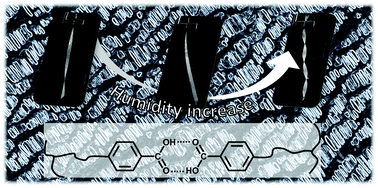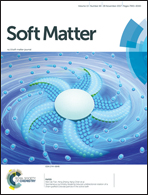Humidity-responsive actuators from integrating liquid crystal networks in an orienting scaffold†
Abstract
Developing shape-shifting materials requires combining the flexibility needed by shape-shifting properties, with the toughness that is demanded to maintain their mechanical performance. Typically, in liquid crystal networks, the amplitude of the shape transformation can be hindered by large cross-linking densities. Here, we argue that a promising strategy to address this limitation consists in integrating liquid crystal networks into an anisotropic and porous material that acts as an orienting scaffold. This strategy shows similarities with the principles of stimuli-responsive deformation in plants, where inflexible elements with specific orientations are integrated into a stimuli-responsive matrix. By aligning liquid crystals in a porous polypropylene orienting scaffold, we demonstrate liquid crystal networks that respond to humidity with a shape change, yet they display high elastic modulus and toughness. Various chiral shapes can be generated in single and double layers of these films, and the complexity of their actuation modes is enhanced, including twisting, curling or winding. We anticipate that these hybrid composites and the strategy they embody can find application to other stimuli-responsive anisotropic soft materials.

- This article is part of the themed collection: Liquid Crystal Elastomers


 Please wait while we load your content...
Please wait while we load your content...